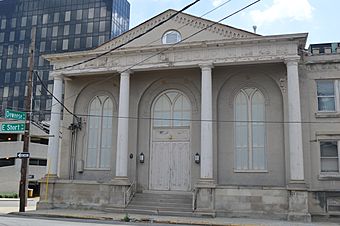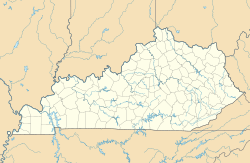First African Baptist Church (Lexington, Kentucky) facts for kids
Quick facts for kids |
|
|
First African Baptist Church
|
|

Front of the church's former building
|
|
| Location | 264-272 E. Short St., Lexington, Kentucky |
|---|---|
| Area | 0.2 acres (0.081 ha) |
| Built | 1856 |
| Architectural style | Italianate, Collegiate Tudor |
| NRHP reference No. | 86000854 |
| Added to NRHP | April 24, 1986 |
First African Baptist Church is a very old and important church in Lexington, Kentucky. It was started around 1790 by Peter Durrett and his wife. They were enslaved people who came to Kentucky with their owner, Rev. Joseph Craig, in 1781. They were part of a group called "The Travelling Church" from Virginia.
This church is the oldest Black Baptist church in Kentucky. It is also the third oldest in the entire United States. It was the first Black church congregation west of the Allegheny Mountains. By 1850, it had over 1,800 members. This made it the largest church in Kentucky at that time. The beautiful church building you see in the picture was built in 1856. By 1861, it had 2,223 members. The church was added to the National Register of Historic Places in 1986. Today, the First African Baptist congregation meets at a newer church building on Price Road.
Contents
The Church's Early Days
Peter Durrett was born into slavery in Caroline County, Virginia. His father was also his owner, Captain Duerrett. When Peter was about 25, he became a Baptist. He married an enslaved woman who lived on Rev. Joseph Craig's land. Peter wanted to stay with his wife. So, his owner traded him to Rev. Craig. This way, Peter and his wife could stay together.
In 1781, Peter and his wife moved with their owner to Kentucky. They traveled with "The Travelling Church" from Virginia. This group was led by Rev. Lewis Craig. Peter helped guide hundreds of people and their enslaved workers on this long, hard journey. It was about 600 miles through the Appalachian Mountains. Because of his help, Peter was called "Old Captain" after the trip.
By 1784, Peter and his wife were part of a Baptist church at Boone's Creek. Rev. Joseph Craig was the pastor there.
Starting a New Congregation
Soon after, Peter Durrett and his wife moved to Lexington. They got permission from Craig to work for others. They worked for a pioneer named John Maxwell. He let them build a cabin on his land in Lexington. This is where Peter Durrett began preaching to other enslaved people.
A historian named Robert Hamilton Bishop wrote about how important Peter's wife was. She helped a lot to get the first church group started. She made sure people had a place to meet. She also encouraged them to be serious about their faith.
Durrett wanted to become an ordained preacher. Many people wanted him to baptize them. He waited because he was not yet ordained. The local Baptist group did not formally ordain him. But they told him to "go on in the name of their common Master." So, Durrett began to baptize people he felt were ready.
The First African Church
Durrett and his wife gathered about 50 people. Most of them were baptized by him. Around 1790, these members formed the First African Church. It is now known as the Historic Pleasant Green Baptist Church in Lexington. Durrett began to lead the Lord's Supper.
This church is the oldest Black Baptist church in Kentucky. It is also the third oldest in the United States. It is the oldest Black church west of the Allegheny Mountains. Its first members were enslaved people and free Black people from the Lexington area. The church bought its first land in 1815. In 1816, it started a religious school. This school continued with teachers who were not ministers.
The church bought its first land in July 1820. The trustees who bought it were Rolla Blue, William Gist, Solomon Walker, and James Pullock. They were all free Black men. In July 1822, the church officially joined with the First Baptist Church of Lexington. This was a white congregation. Peter Durrett lived until 1823. He was almost 90 years old. His church had about 300 members by then.
London Ferrill's Leadership
After Peter Durrett passed away in 1823, Rev. London Ferrill became the new preacher. He was chosen by the Lexington city trustees. London Ferrill used to be an enslaved person in Hanover County, Virginia. He became free when he was a young man. He was likely the son of his first owner.
London Ferrill was not formally educated. But he was a very powerful preacher. He also worked as a skilled carpenter. He and his wife moved to Kentucky and settled in Lexington. He was ordained as a preacher by the First Baptist Church (mostly white members). Then he was asked to lead the First African Baptist Church. He was a respected leader among both Black and white communities.
Ferrill served the church for almost 31 years. After he became pastor, his church joined the Elkhorn Association of the Baptist Church. Lexington grew, and the First African Baptist church gained many new members. Most were enslaved, but some were free Black people. In 1833, the church bought an old Methodist Meeting House. They met there for several years.
Under Ferrill's leadership, the church grew from 280 members to 1,820 members by 1850. At that time, it was the largest church in Kentucky, for both Black and white people.
In 1833, there was a serious sickness called cholera. Ferrill was one of only three religious leaders who stayed in the city to help people. His own wife died during this time. He would marry enslaved people with special words. He would say they were "united until death or distance did them part." This was because many enslaved people were sold far away from their families.
London Ferrill died suddenly in 1854 from a heart attack. His funeral procession was huge, with almost 5,000 people. It was said to be the largest funeral in Lexington after that of the famous statesman Henry Clay two years before. Ferrill was the only Black person buried in the Old Episcopal Burying Ground of Christ Church.
In 1856, First African Baptist finished building their new church. It was designed in the popular Italianate style, with large, arched windows. By the start of the American Civil War in 1861, the church had 2,223 members.
After the Civil War
After the Civil War, most Black Baptist churches wanted to be independent. They no longer wanted white supervision. So, First African Baptist left the Elkhorn Baptist Association. They soon joined a state group of Black Baptist churches. Today, the congregation is part of the National Baptist Convention, USA. This is the largest group of African-American Baptists.
In 1987, the First African Baptist congregation sold its historic downtown building. It was bought by the nearby Central Christian Church. They used it as a childcare center. The First African Baptist congregation moved to a new building at 635 Price Road in the 1980s.
Honors
- The church building from 1856 was added to the National Register of Historic Places in 1986.
- In 2008, Christ Church Cathedral named its community garden after London Ferrill. He was the second preacher of First African Baptist.
- In 2010, Christ Church helped get a city monument approved for London Ferrill. It was placed at the Old Episcopal Burying Ground. The state has also put up a highway marker at the site to remember him.



